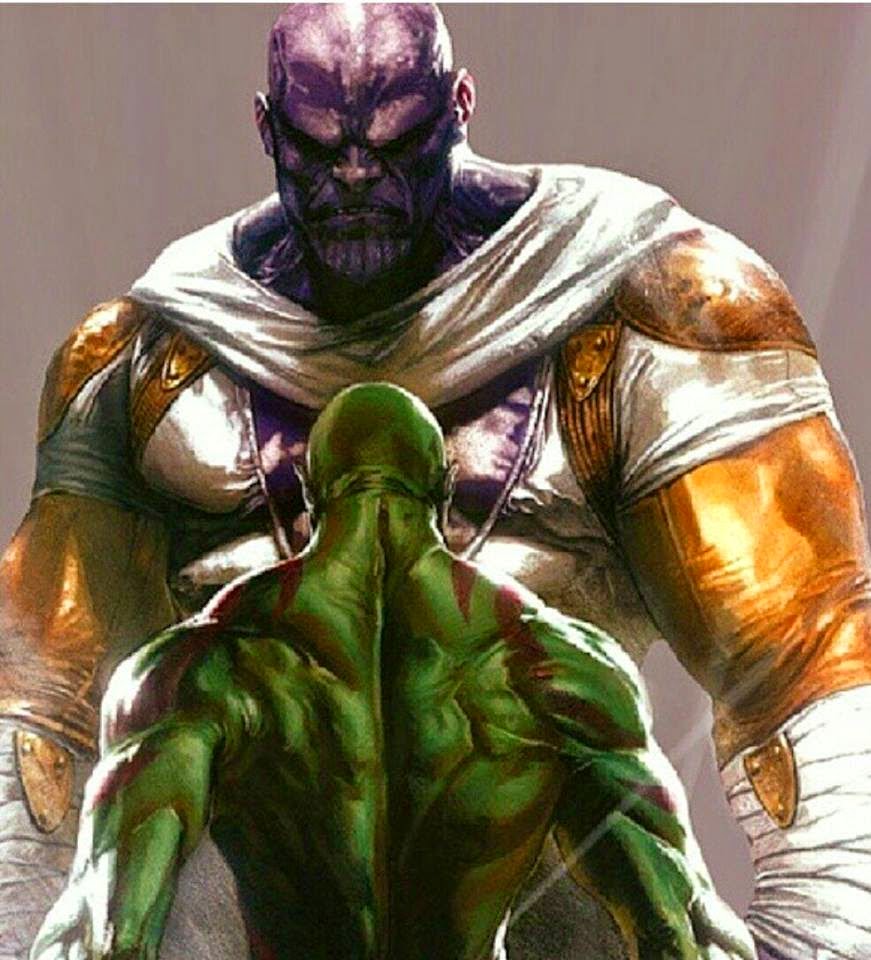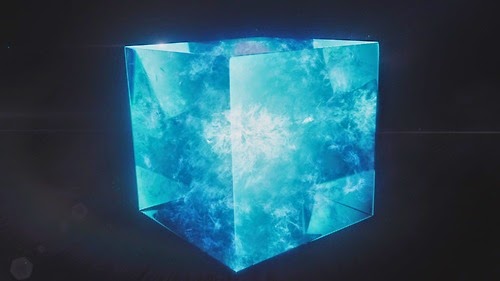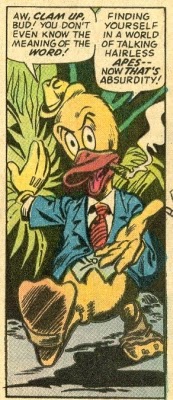
Did you see Guardians of the Galaxy? Good, then this blog will not spoil the movie but hopefully it will answer a few questions. If you haven't seen the movie yet and you don't like your surprises spoiled, then please go see the movie. I will wait right here . . ..
Welcome back! Now that we are all free from fear of spoilers, let's talk about what you saw. Guardians of the Galaxy may win the prize for greatest Easter Eggs in a single Marvel film. It connects to the more than 70 years of Marvel Comics Universe material, but it also has the advantage of linking into the now well-established Marvel Cinematic Universe. Here are the most notable connections in the film:
 1. The original Guardians of the Galaxy, who are actually from the future. Yes, it can be confusing. The original Guardians of the Galaxy appeared in Marvel Super Heroes #18 in 1969. Their adventures were set in the solar system of the 31st century where they battled for the freedom of all planets against the tyrannical lizard-like Badoon. This original yet future team was created by Arnold Drake and Gene Colan. Among the team members was Yondu, a blue-skinned alien from Centauri IV. Yondu fought with a bow and arrow, but his arrows had a special ability. They were made from a sound-sensitive metal called yaka. Yondu can whistle a note and the arrows will change direction.
1. The original Guardians of the Galaxy, who are actually from the future. Yes, it can be confusing. The original Guardians of the Galaxy appeared in Marvel Super Heroes #18 in 1969. Their adventures were set in the solar system of the 31st century where they battled for the freedom of all planets against the tyrannical lizard-like Badoon. This original yet future team was created by Arnold Drake and Gene Colan. Among the team members was Yondu, a blue-skinned alien from Centauri IV. Yondu fought with a bow and arrow, but his arrows had a special ability. They were made from a sound-sensitive metal called yaka. Yondu can whistle a note and the arrows will change direction. 

Yondu in the movie is different than the character in the 1969 comic. He still has blue skin and a trick arrow, but he is not from the future and leads the Ravagers. And what happened to his bow and the fin on his head? Did you notice that his metal mohawk glows red when he is controlling the guided drone arrow? That's a callback to the comic book character.
 Dan Abnett and Andy Lanning developed a new team named the Guardians of the Galaxy in 2008. Among the team members were Star-Lord, Drax, Gamora, Rocket Racoon, and Groot. Each of these characters was drawn from earlier comic stories. Groot is the first of the team to ever appear in a comic. He's even been around longer than the Fantastic Four or the original Guardians of the 31st century who first appeared in 1969. Groot was a monster from Planet X in Tales to Astonish #13 (1960). Drax and Gamora (as well as Thanos) were created by Jim Starlin. Rocket Racoon, who's name and story are a spoof on the Beatles song Rocky Racoon, was created by Bill Mantlo and Keith Giffen. There were two other members of the 2008 Guardians who did not make it into the film. One was Adam Warlock (more on him below) and the other was Quasar, a sword wielding warrior woman who's ancestry can be traced back to . . .
Dan Abnett and Andy Lanning developed a new team named the Guardians of the Galaxy in 2008. Among the team members were Star-Lord, Drax, Gamora, Rocket Racoon, and Groot. Each of these characters was drawn from earlier comic stories. Groot is the first of the team to ever appear in a comic. He's even been around longer than the Fantastic Four or the original Guardians of the 31st century who first appeared in 1969. Groot was a monster from Planet X in Tales to Astonish #13 (1960). Drax and Gamora (as well as Thanos) were created by Jim Starlin. Rocket Racoon, who's name and story are a spoof on the Beatles song Rocky Racoon, was created by Bill Mantlo and Keith Giffen. There were two other members of the 2008 Guardians who did not make it into the film. One was Adam Warlock (more on him below) and the other was Quasar, a sword wielding warrior woman who's ancestry can be traced back to . . .  |
| Fantastic Four #65 (1967) |
 |
| Agent Coulson and Dead Blue Alien |
Most Kree are blue skinned. However some are pink skinned, which means they look like light skinned, white humans. Blue and pink Kree have been known to be prejudiced to one another. It can be a cruel empire. Captain Marvel, is the best known Kree of them all. He came to earth as our enemy and turned out to be a hero. He died of cancer before his time, but he did save the universe all from the villainy of .....
 |
| "Courting Death makes him smile." |

See, that's complicated and not nearly as simple as "My name is Drax the Destroyer. You killed my family. Prepare to die." It worked for Inigo Montoya.
Thanos will be back as he searches for . . .
 |
| Collect All Six! |
4. The Infinity Stones. In the comics they are known as the Infinity Gems. Six gems each with a specific power. When you put them all together they make an Infinity Gauntlet.
 |
| Infinity Gauntlet |
In the cinematic universe, the Infinity Stones are the super-powered Lucky Charms of the universe. In Thor: The Dark World, Odin read an Asgardian storybook to us that explained the Infinity Stones. Now in Guardians the Collector showed us a little film strip history of the stones. That large glowing being who was one of the original users of the Infinity Stones is a Celestial.
 |
| Don't Judge Me, Celestial! |
In the comics, the Celestials are a race of giant robot looking creature who show up and judge planets; they are sort of like nosy relatives at the holidays but on a larger scale. They were created by writer-artist Jack Kirby and made their first appearance in Eternals #1 (1976).
 We have seen the blue tesseract in action: It was used by Odin in the 10th century to protect Norway (Thor: Dark World). The Red Skull and Arnim Zola used it to power super-weapons for HYDRA in World War II (Captain America: First Avenger). Howard Stark recovered it and researched it (Iron Man 2) and Nick Fury gave it to Eric Selvig so that he could discover how to tap its energy (Thor). The tesseract was used to open the portal to earth that allowed the Chitauri to begin their invasion (Avengers).
We have seen the blue tesseract in action: It was used by Odin in the 10th century to protect Norway (Thor: Dark World). The Red Skull and Arnim Zola used it to power super-weapons for HYDRA in World War II (Captain America: First Avenger). Howard Stark recovered it and researched it (Iron Man 2) and Nick Fury gave it to Eric Selvig so that he could discover how to tap its energy (Thor). The tesseract was used to open the portal to earth that allowed the Chitauri to begin their invasion (Avengers). |
| What's the current rate for Aether? |
Now we can add the Orb to our collection. This purple jewel is really nasty. It eats up everything. Odin gave the Aether to The Collector because he didn't want two Infinity Stone in the same place. And yet The Collector is about to add the Orb to his collection and he already has the Aether. Of course it did not work out too well. This leads us to the man with all the Easter Eggs. . . .
5. The Collector. In the comics, he is one of the "Elders of the Universe." The elders are ancient beings, the last of their kind. They take on a single function, like collecting or gardening, sort of like actual retired people. The Collector has fought the Avengers many times and he usually summons weapons or creatures from his collection to use in the fight. The name of his magenta slave-girl, Carina, is the name of his daughter in one comic storyline.
When Guardians comes out on Blue Ray, I will be searching the background for object in the Collectors gallery. What was immediately visible were the following:
 |
| When Nova Met Cosmo |
- a Dark Elf from Thor: Dark World. Carina is washing the window of his cage
- a Chitauri from the Avengers.
- Cosmo the Space Dog. That dog in the Russian space suit is a character in the 2008 GOTG comic book series. He originally appeared in volume four of Nova, issue 8. Cosmo was a Soviet space dog who got lost in space and ended up at Knowhere - the giant floating head in space. Cosmo developed psionic powers and made a living as the security chief of Knowhere. He was helped in his adventures by an Earthman named Richard Rider, also known as Nova who was given powers by the Nova Corps of the planet . . .
7. Spartax. Star-Lord's origin has been rewritten many times. The creators of the character were Steve Engleheart and Steve Gan. In his first appearance in Marvel Preview #4 (1976), it was suggested that he was a new messiah and his birth was perhaps a virgin birth, hence the name Star-LORD. That origin story did not endure and after a few reboots, Star-Lord soon became more of the space pirate depicted in the film. His roots on earth were maintained but the identity of his father was revealed as a the prince of the Spartax empire, who crash landed on earth and fell in love with an earth girl. In the comics, Star-Lord knows his father, J-Son, who is King of the Spartoi and a political manipulator. The stage is set to reveal Quill's father for the sequel, but it remains to be seen how close the filmmakers will adhere to the comics. For all we know they could reveal that Star-Lord's father is ....
 |
| Fear #19 |
 Howard was a misplaced native of Duckworld who fell through a cosmic nexus and landed on Earth. He was trapped in a world he never made. The comic book adventures of Howard were popular for its intelligent satire, humor, and relevant commentary. Howard even ran for president in 1976 and the character received write-in votes in the actual election.
Howard was a misplaced native of Duckworld who fell through a cosmic nexus and landed on Earth. He was trapped in a world he never made. The comic book adventures of Howard were popular for its intelligent satire, humor, and relevant commentary. Howard even ran for president in 1976 and the character received write-in votes in the actual election.  The first Marvel movie ever released was Howard the Duck. It was released on August 1, 1986, exactly twenty-eight years prior to the release of the Guardians of the Galaxy. The Howard the Duck film had none of the wit of the comic book and the character was creepier that anyone intended. The 1986 film is justifiably regarded as one of the worst films ever made and George Lucas would probably prefer that that we all forget he had anything to do with it. Yet, he is probably prouder of Howard the Duck than he is with The Star Wars Holiday Special.
The first Marvel movie ever released was Howard the Duck. It was released on August 1, 1986, exactly twenty-eight years prior to the release of the Guardians of the Galaxy. The Howard the Duck film had none of the wit of the comic book and the character was creepier that anyone intended. The 1986 film is justifiably regarded as one of the worst films ever made and George Lucas would probably prefer that that we all forget he had anything to do with it. Yet, he is probably prouder of Howard the Duck than he is with The Star Wars Holiday Special.



